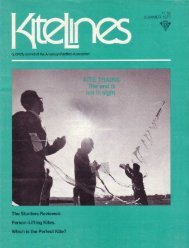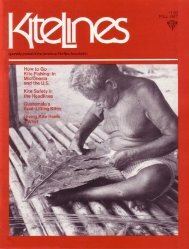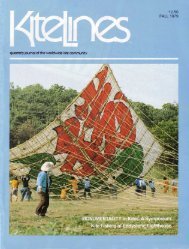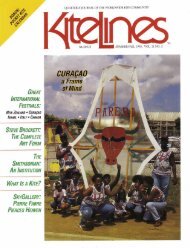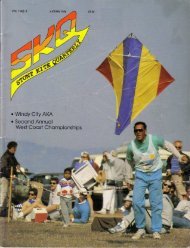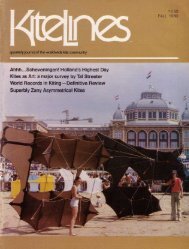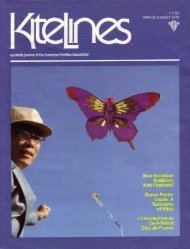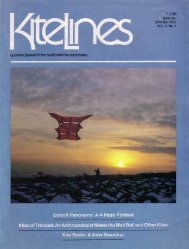Kite Lines - Vol.3 No. 1 - KiteLife
Kite Lines - Vol.3 No. 1 - KiteLife
Kite Lines - Vol.3 No. 1 - KiteLife
- No tags were found...
You also want an ePaper? Increase the reach of your titles
YUMPU automatically turns print PDFs into web optimized ePapers that Google loves.
designs, today's kites are an art form, fitfor a gallery. But they hang best in thesky . In getting started, your only problemmay be deciding on a kite . It'simpossible to recommend one type ofkite over another, since each has itsown personality . Discovering them willbe your private delight .Another option open to the avid kiteris making your own kite . You may firstbecome enraptured by commercialmodels . In fact, few kiters are weanedfrom them entirely. But many kitersare soon led into making somethingwith their own hands . There's specialgratification in building one's own birdand setting it flying . Many artists havefound in kites a medium of creativeexpression unlike anything else . Theexpenditure of hours of planning andconstruction can be more than equivalentto the cost of the ready-to-fly kites .Most kites on today's market requireminimum assembly and are very easyto fly . But it can prevent problems ifyou check out your kite before flyingit . Look first for balance and properbridling . A well-balanced kite will beevenly weighted side-to-side, will havea symmetrical shape and frame, andwhen suspended from its towing pointwill rock gently and find a balancerather than flip all the way to one side.A kite's bridle should position the kite'sleading edge about 15 degrees higherthan its trailing edge when suspendedfrom its towing point .The bridle is the first point of correctionto check on an ill-behavingkite . Two of the most common bridlingdefects are unequal leg lengths anda too-short bridle . In a light wind, youmay want to increase the angle ofattack with a lower bridle ; in strongwind, you can spill more air with ahigher towing hitch . A little experimentationwill help you find optimumbridle settings . Take to the field-with-your kite-repair materials and (if you'reflying a flat kite or a touchy bowed one)tails, such as crepe paper streamers orrags. Many a cranky kite settles downwith a tail as a baby does with a securityblanket . See that your line is wound onsome kind of reel or winder . Even a tincan is far better for line handling thana fumble-thumbs ball of string . Bewarethe new ball when you reach the end ofthe line, which is rarely tied to the core!<strong>No</strong>w prepare to launch . For most kites,have a friend walk your kite out about100 feet from you . The wind will be atyour back and in the face of yourhelper and your kite . Have your friendhold the kite lightly by the center sticks .If there is a tail on the kite, extend itfully on the ground in front of the kite .When you're ready and you feel thewind is right, signal or call to your assist.ant for release while you hold the linetaut-and watch the kite rise! You won'thave to run . Just keep tension on theline and let it out smoothly and fastenough for the kite to gain altitude"Pumping" the line spurs lift if thewind is sluggish. Once the kite is upabove the ground turbulence, it willusually settle nicely into the steadyupper breezes .If you encounter a no-wind situation,your alternatives are these : (1) usea lighter kite ; (2) make a "high-start"launch, one even further from yourassistant, such as 200 to 500 feet(3) accept the conditions with grace :there will be another day .As you practice launching, you'llsoon learn ways to do it without ahelper, working your kite right offyour hand and into the sky . (Of course,very large kites always require help . InJapan, whole teams of 100 people flygigantic 48 x 36-foot kites on ropes 1'hinches thick .) You'll also learn how tohandle line and how to land a kite, slackingthe line so the kite doesn't crash, or"walking down" the kite, letting afriend reel in while you walk towardthe kite with the line under your arm .As your kite flies, keep an eye on it .Some kites are so stable they can be tiedoff and left untended . But other kites,less predictable, may need observation .There's a difference of opinion onthe subject of altitude . Some want theirkites far out, to the point of invisibility ;others want to see and manipulatetheir kites .Proficiency in kiting is largely amatter of experience . That holds trueespecially for maneuverable kitesfighters(one-line maneuverables) andstunters (dual-line controlled) . Thesekites are the sport's new wave, dancingthrough the sky . Tournaments to pitskills are on the increase in the U .S .,and include patterned measures ofexecution for stunter kites . "Figurekiting" includes hedge-hopping, diving,figure eights and more, as well as freestyle,poetically performed to music .One caution : maneuverables must behandled with respect because they arespace-consuming and people-threateningas they swoop over terrain ; i .e ., theyare not to be flown on crowded beaches .New enthusiasts can hasten their immersionin the sport through reading .Many kiters recommend <strong>Kite</strong>s, byWyatt Brummitt (Golden Guide series),a buy at $1 .95 . Top choice for a comprehensivebook is The Penguin Bookof <strong>Kite</strong>s by David Pelham at $4 .95 .still available in many stores . Threeother good texts (each $4 .95) are Hiroi's<strong>Kite</strong>s . Sculpting the Sky, Newmans'<strong>Kite</strong> Craft and Yolen's Complete Bookof <strong>Kite</strong>s and <strong>Kite</strong> Flying . An art bookabout kites is sculptor Tal Streeter'sThe Art of the Japanese <strong>Kite</strong>, $17 .50.To become an all-out member ofthe kiting family, the quarterly journal<strong>Kite</strong> <strong>Lines</strong> is indispensable at $9 .00 ayear. It contains national and internationalnews of kiting events, constructionplans and techniques, profilesof kiters, kite and book reviews,in-depth feature articles-and somevery interesting advertising. New subscriptionsstart with the <strong>Kite</strong> <strong>Lines</strong>Annotated <strong>Kite</strong> Bibliography, whichlists and evaluates nearly every book inprint on the subject of kites . <strong>Kite</strong> <strong>Lines</strong>reflects and nurtures the growing worldwidecommunity of kite enthusiasts . Itis located at 7106 Campfield Road .Baltimore, Maryland 21207, USA .<strong>Kite</strong> <strong>Lines</strong> recently expressed somephilosophy that kiters are repeating :<strong>Kite</strong>s make the worldseem smallerand the skyseem bigger .May you find this secret and manyothers for yourself as you explore thisancient pastime and modern sport .©<strong>Kite</strong> <strong>Lines</strong> 1980All rights reserved . However, permissionto copy this leaflet is granted to anyoneprovided it is reproduced in full . Partialuses are strictly prohibited withoutprior written consent from <strong>Kite</strong> <strong>Lines</strong>s



